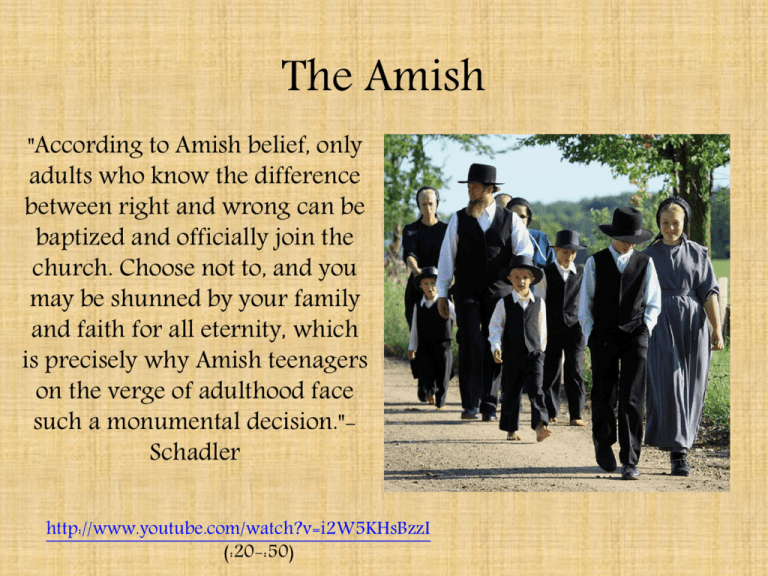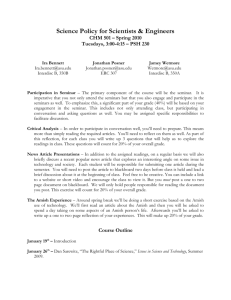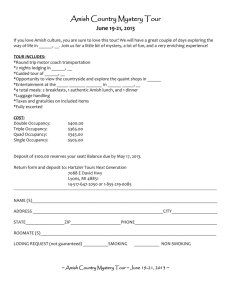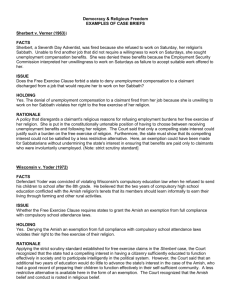Amish - St. Edwards University
advertisement

The Amish "According to Amish belief, only adults who know the difference between right and wrong can be baptized and officially join the church. Choose not to, and you may be shunned by your family and faith for all eternity, which is precisely why Amish teenagers on the verge of adulthood face such a monumental decision."Schadler http://www.youtube.com/watch?v=i2W5KHsBzzI (:20-:50) Intro • A group of traditionalist Christian church fellowships that are a subgroup of the Mennonite churches • Known for simple living, plain dress, and reluctance to adopt modern technology • Have their own unwritten code called the Ordnung; stresses the virtues of humility, obedience and simplicity • Began in Switzerland led by Jakob Ammann; those who followed him became known as the Amish Intro • Currently communities in 27 of the U.S. states and the Canadian province of Ontario • Ohio, Pennsylvania and Indiana have the largest population • Currently, there is a rapid population growth in Amish communities so new settlements are being grown or formed Education Goals: to teach children the worth of hard work, ethical living, and how to be a valuable member of the Amish community • Preschool: – The Amish have no pre-school – They believe that it is important that very young children are with their parents and learning under their guidance • Post school: After 8th grade, Amish education moves from the school back to into the home and community Education • Female adolescents as teachers: – 8th grade education; it is more important that she is strong in faith and will stick to the Amish way of thinking as she teaches the children – Chosen members from society – A new teacher is usually a young girl – Men usually do agricultural work therefor, it leaves women as teachers Education • Is Amish Education Adequate? – This successfully achieves the goal of preparing Amish kids to become outstanding members of the Amish society while having the skills to do business in the outside world Religion • Relating to a Baptist sect • Private people who believe that God has called them to live a simple life of faith, discipline, dedication and humility • Believe that God has a personal abiding interest in their lives, families, and communities and that’s why they should be separated from the rest of the world Religion • Faith-based Amish traditions include wearing plain clothing, living in a simple manner and helping a neighbor in need • Communities are divided into church districts geographically, which enables services to be held in church members’ homes • One of their biggest beliefs is against infant baptism – a person needs to be old enough to make that decision; this usually takes place after Rumspringa Family Relationships • Amish families tend to settle around each other, growing up and living surrounded by their extended family. • When an Amish family moves into a home they usually stay there for life, this is especially true of those who settle near their extended families. Family Relationships • Families are generally started during late adolescence after Rumspringa • Families have an average of 6 children per household. • Having a large family is greatly valued by the church, who wishes to continue growth to their community. • The traditional Amish family works and does chores everyday and attends service every other Sunday. Marriage • Marriage generally occurs around the ages of 18-21 in late adolescence • In a marriage, the man is the leader of the family and the primary breadwinner making all of the major decisions for the family, business, and household. • The degree to which a wife is included in decision making varies from family to family. • A traditional Amish family depends on both parents being active and present for the supervision and raising of the children. Marriage: Roles • Traditionally the wife is in charge of the household she cooks, cleans, and is the seamstress of the home as well. • Other responsibilities include: childcare, yard work, laundry, food preservation, helping with barn chores and harvesting. • A young Amish girl is expected to practice these skills to prepare her for her own household. Amish Dating • Children normally attend school until about the 8th grade, leaving few places for teens to socialize and meet potential partners. • Amish customs on dating differ greatly from church to church, each following their own Ordnung. • Courtship traditionally begins around the ages of 14 and 15 for girls, and around 16 for boys. Sunday Night Singing • Teens stay after church on alternating Sundays to participate in Sunday night singing • boys and girls are seated at a long table facing each other • between songs teens have plenty of time to socialize, as well as 2 hours of socializing after singing is done • If a couple hits it off, the boy then asks the girl if he can drive her home where they may sit up the whole night getting to know one another while the household is asleep • If couples are willing they can start seeing each other regularly and going steady • On weekends when there is no Sunday service the teens will usually go out on Saturday nights, Amish Dating • More conservative couples follow traditional dating practices, dating in buggies and participating in group activities or activities with parents as well. • Couples that follow more progressive church teaching may go into town for a date or even drive into town, although this group is a very small minority. http://www.youtube.com/watch?v=5lKlBPdgA_E (1:00-2:00) Bed Courtship • Another method that some Amish traditions utilize is bed courtship. • In this practice the boy will ask the girl if he may drive her home, if she accepts they will go to her home go upstairs and get into her bed fully clothed. • Teens must follow tradition and are expected not to touch but only talk throughout the night. • Bed courtship is a tradition practiced only by very conservative churches. Social Aspects • More lenient free time – Teens in some Amish communities have the freedom to: • • • • Wear tight jeans Put subwoofer’s in their buggy Use a cell phone Go to Sunday singings for social interactions Adolescence, for the Amish, seems to be a time where a person is held accountable for forming their concept of right and wrong. They are out of school, they have their own responsibilities to manage themselves and their faith and to determine what is right and wrong. This is why they are also given some freedom to explore modern and non-Amish things. Social Aspects • Examples of common teen social activities: – Go to Sunday singings – Go bowling – Some teens may even be allowed to go to parties Note: Some Amish teens go to community events in order to meet a significant other that they can one day marry. While it is true that some Amish teens engage in more wild behavior, especially during Rumspringa, many Amish teens stay closer to what they know and in more expected social spheres Social Aspects • Differing Expectations and Freedoms – 40 different Amish affiliations in the U.S. “Some of the subgroups are very conservative, very isolated, and doing very well protecting their way of life because they basically reject much more technology than the more progressive ones” – Kraybill Social Aspects • This difference can have a huge impact on the social expectations of teens in the Amish communities. In progressive communities, teens may feel they have incremental freedoms that slowly allow them to gain some autonomy. • In more authoritarian situations and conservative communities, it is not very uncommon that a teen will attempt to run away, leaving everything they know behind forever. • Because of this, the social expectations and norms of how Amish teens gain autonomy and what level of autonomy they gain during adolescence can differ a lot on a case by case basis. Rumspringa • “running around” • Youth in the Amish community temporarily leaves the community to experiences the world • During this period, they are no longer under control of their parents, not under authority of the church • Begins at 14-16 and ends when a youth (boys more than girls) chooses baptism within Amish church or instead leaves community. • At the end, faced with choice to return to Amish community or reject it Note: vast majority choose baptism and remain in the church Rumspringa • Elders generally view this time as a time for courtship and finding a spouse • Most youth continue traditional Amish behavior, others experiment with worldly behaviors: – – – – Buying a car Going to the movies Wearing non-Amish clothes Buying a T.V./DVD player • Knowing they have a choice likely strengthens their willingness to obey church standards and, in the long run, the authority of the church itself Conclusion • Hard to define adolescence in the Amish community References A Look at Amish Education. (2010, November 17). Retrieved from http://www.exploring-amishcountry.com/amish-education.html Amish America. (2010). What is Rumspringa? Retrieved November 28, 2013, from http://amishamerica.com/what-is-rumspringa/ Amish Studies. (2013). Rumspringa. Retrieved November 28, 2013 from http://www2.etown.edu/amishstudies/Rumspringa.asp Brady, J. (2013, September 2). Amish community not anti-technology, just more thoughtful. Retrieved December 1, 2013, from NPR website: http://www.npr.org/blogs/alltechconsidered/2013/09/02/217287028/amish-community-not-antitechnology-just-more-thoughful Fulong, S. (2012, June 13). About Amish. That Rumspringa Misconception, Again. Retrieved November 28, 2013, from http://aboutamish.blogspot.com/2012/06/that-rumspringa-misconception-again.html Lindener-Stawski, G. (n.d.). Patterns of amish courtship. Retrieved November 24, 2013, from http://web.missouri.edu/~hartmanj/rs150/papers/ws993-1.html Neal, C. (n.d). Rumspringa: Amish teens venture into modern vices. Talk Of The Nation (NPR), Amish customs. (n.d.). Retrieved November 28, 2013, from Exploring Amish Country website: http://www.exploring-amish-country.com/amishcustoms.html Schadler, J. (2009). Will Amish teens commit to old lifestyle?. 20/20 (Abc), 1. Townes and Heritage of Amish Communities. (2007, April 1). Retrieved fromhttp://www.padutchcountry.com/towns-and-heritage/amishcountry/amish-religious-traditions.asp Stevick, R. (2007). Growing Up Amish: The Teenage Years. Baltimore: Johns Hopkins University Press.






